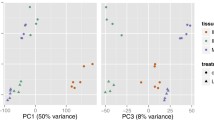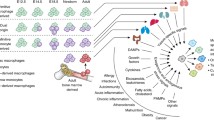Abstract
Macrophages are professional innate immune cells that are broadly disseminated throughout the body, shape various innate and adaptive immune responses, and play crucial roles in inflammation, homeostasis, wound healing, and tissue remodelling. According to their surrounding microenvironments, macrophages can differentiate themselves in different phenotypes. Over the last two decades, gene expression profiling has been used to decipher new transcripts associated with macrophage phenotypes. This chapter outlines protocols used to isolate and culture murine macrophages and how they can be “polarized” to obtain a specific phenotype. Furthermore, we describe a protocol for gene expression profiling using a quantitative real-time polymerase chain reaction (qPCR), a high-standard technology in the field of gene expression.
Access this chapter
Tax calculation will be finalised at checkout
Purchases are for personal use only
Similar content being viewed by others
References
Wynn TA, Chawla A, Pollard JW (2013) Macrophage biology in development, homeostasis and disease. Nature 496(7446):445
DeNardo DG, Ruffell B (2019) Macrophages as regulators of tumour immunity and immunotherapy. Nat Rev Immunol 19:369–382
Okabe Y, Medzhitov R (2016) Tissue biology perspective on macrophages. Nat Immunol 17(1):9
Eissa N, Hussein H, Kermarrec L, Ali AY, Marshall A, Metz-Boutigue M-H et al (2018) Chromogranin-a regulates macrophage function and the apoptotic pathway in murine DSS colitis. J Mol Med 96(2):183–198
Eissa N, Hussein H, Kermarrec L, Elgazzar O, Metz-Boutigue M-H, Bernstein CN, Ghia J-E (2017) Chromofungin (CHR: CHGA47-66) is downregulated in persons with active ulcerative colitis and suppresses pro-inflammatory macrophage function through the inhibition of NF-κB signaling. Biochem Pharmacol 145:102–113
Eissa N, Hussein H, Kermarrec L, Grover J, Metz-Boutigue M-HE, Bernstein CN, Ghia J-E (2017) Chromofungin ameliorates the progression of colitis by regulating alternatively activated macrophages. Front Immunol 8:1131
Eissa N, Hussein H, Hendy GN, Bernstein CN, Ghia J-E (2018) Chromogranin-A and its derived peptides and their pharmacological effects during intestinal inflammation. Biochem Pharmacol 152:315–326
Eissa N, Hussein H, Mesgna R, Bonin S, Hendy G, Metz-Boutigue M-H et al (2018) Catestatin regulates epithelial cell dynamics to improve intestinal inflammation. Vaccine 6(4):67
Rőszer T (2015) Understanding the mysterious M2 macrophage through activation markers and effector mechanisms. Mediat Inflamm 2015:1
Gautier EL, Shay T, Miller J, Greter M, Jakubzick C, Ivanov S et al (2012) Gene-expression profiles and transcriptional regulatory pathways that underlie the identity and diversity of mouse tissue macrophages. Nat Immunol 13(11):1118
Taylor S, Wakem M, Dijkman G, Alsarraj M, Nguyen M (2010) A practical approach to RT-qPCR—publishing data that conform to the MIQE guidelines. Methods 50(4):S1–S5
Gonçalves R, Mosser DM (2015) The isolation and characterization of murine macrophages. Curr Protoc Immunol 111(1):14.11.11–14.11.16
Zhang X, Goncalves R, Mosser DM (2008) The isolation and characterization of murine macrophages. Current Protoc Immunol 83(1):14.11.11–14.11.14
Cunnick J, Kaur P, Cho Y, Groffen J, Heisterkamp N (2006) Use of bone marrow-derived macrophages to model murine innate immune responses. J Immunol Methods 311(1–2):96–105
Rios FJ, Touyz RM, Montezano AC (2017) Isolation and differentiation of murine macrophages. Editors: Rhian M. Touyz Ernesto L. Schiffrin. Methods Mol Biol 1527:297–309. https://doi.org/10.1007/978-1-4939-6625-7_23
De Nardo D, Kalvakolanu DV, Latz E (2018) Immortalization of murine bone marrow-derived macrophages. Editor: Germain Rousselet. Methods Mol Biol 1784:35–49. https://doi.org/10.1007/978-1-4939-7837-3_4
McQuattie-Pimentel AC, Budinger GS, Ballinger MN (2018) Monocyte-derived alveolar macrophages: the dark side of lung repair? Am J Respir Cell Mol Biol 58:5–6; American Thoracic Society
Glass CK, Natoli G (2016) Molecular control of activation and priming in macrophages. Nat Immunol 17(1):26
Gordon S (2007) The macrophage: past, present and future. Eur J Immunol 37(S1):S9–S17
Mosser DM, Edwards JP (2008) Exploring the full spectrum of macrophage activation. Nat Rev Immunol 8(12):958
Mosser DM, Zhang X (2008) Activation of murine macrophages. Current Protoc Immunol 83(1):14.12.11–14.12.18
Eissa N, Hussein H, Wang H, Rabbi MF, Bernstein CN, Ghia J-E (2016) Stability of reference genes for messenger RNA quantification by real-time PCR in mouse dextran sodium sulfate experimental colitis. PLoS One 11(5):e0156289
Eissa N, Kermarrec L, Hussein H, Bernstein CN, Ghia J-E (2017) Appropriateness of reference genes for normalizing messenger RNA in mouse 2, 4-dinitrobenzene sulfonic acid (DNBS)-induced colitis using quantitative real time PCR. Sci Rep 7:42,427
Bustin SA, Benes V, Garson JA, Hellemans J, Huggett J, Kubista M et al (2009) The MIQE guidelines: minimum information for publication of quantitative real-time PCR experiments. Clin Chem 55(4):611–622
Schmittgen TD, Livak KJ (2008) Analyzing real-time PCR data by the comparative CT method. Nat Protoc 3(6):1101–1108
Eissa N, Hussein H, Diarra A, Elgazzar O, Gounni AS, Bernstein CN, Ghia J-E (2019) Semaphorin 3E regulates apoptosis in the intestinal epithelium during the development of colitis. Biochem Pharmacol 166:264
Kermarrec L, Eissa N, Wang H, Kapoor K, Diarra A, Gounni AS et al (2019) Semaphorin 3E attenuates intestinal inflammation through the regulation of the communication between splenic CD11C+ and CD 4+ CD 25-T cells. Br J Pharmacol 176:1235
Acknowledgments
This chapter is supported by grants from the Canada Foundation for Innovation, Crohn’s and Colitis Canada, Research Manitoba, the Children’s Hospital Research Institute of Manitoba, the Natural Sciences and Engineering Research Council, and finally the Canadian Institutes of Health Research, to Jean-Eric Ghia. Nour Eissa is supported by the Canadian Institutes of Health Research (CIHR) (Grant# 395678), Children’s Hospital Research Institute of Manitoba, Health Science Centre Foundation (HSCF)-Mindel, and the Tom Olenick Research Excellence Award in Immunology and the MITACS Accelerate Program.
Author information
Authors and Affiliations
Corresponding author
Editor information
Editors and Affiliations
Rights and permissions
Copyright information
© 2020 Springer Science+Business Media, LLC, part of Springer Nature
About this protocol
Cite this protocol
Eissa, N., Hussein, H., Ghia, JE. (2020). A Gene Expression Analysis of M1 and M2 Polarized Macrophages. In: Mishra, S. (eds) Immunometabolism. Methods in Molecular Biology, vol 2184. Humana, New York, NY. https://doi.org/10.1007/978-1-0716-0802-9_10
Download citation
DOI: https://doi.org/10.1007/978-1-0716-0802-9_10
Published:
Publisher Name: Humana, New York, NY
Print ISBN: 978-1-0716-0801-2
Online ISBN: 978-1-0716-0802-9
eBook Packages: Springer Protocols




